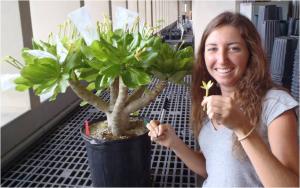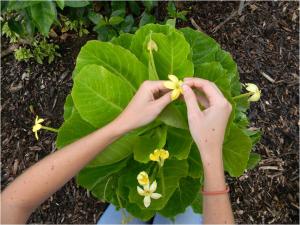By Staff Reports
(Honolulu)– UH Mānoa graduate student Seana Walsh, a candidate for a Masters degree in the Department of Botany, has been awarded the Eloise Gerry Fellowship from the Sigma Epsilon/Graduate Women in Science National Fellowships Program to continue her research on a critically endangered Hawaiian plant endemic to Kaua‘i and historically to Ni‘ihau—the ‘ōlulu, or “cabbage on a stick” plant, Brighamia insignis.
The plant is considered one of the most unusual in the Hawaiian flora. In the wild, only one individual is thought to survive, clinging to a sea cliff along Kaua‘i’s Nā Pali Coast.
“Having been born and raised in the Hawaiian islands, I have witnessed the rapid extinction of numerous plant and animal species found nowhere else on this planet,” said Walsh, who was born on Kaua‘i and raised on Maui. She attended Maui Community College before completing her undergraduate degree in Botany at UH Mānoa in 2011.
“I have a great desire to focus on conserving and protecting Hawai‘i’s flora and fauna,” she said. “This feels only natural to me, and I am committed to a career that will advance these goals.”
As an undergraduate at UH Mānoa, Walsh got her start in research with a grant from the Undergraduate Research Opportunities Program. She now works with graduate adviser Curtis Daehler, a professor in the Department of Biology.
Walsh will use her new graduate fellowship to conduct a pollination study of B. insignis. Its fragrant yellow and white flowers are believed to be adapted for moth pollination, but no aspect of the species’ reproductive biology has been investigated experimentally. It has been included on the federal endangered species list since 1994.
Using a small set of cultivated B. insignis plants under the care of staff at the National Tropical Botanical Garden’s Limahuli Garden on Kaua‘i, Walsh will observe the plants during the day and night to determine if any local pollinators are visiting its flowers.
Walsh will also document various aspects of the unique plant’s floral biology, including the volume of nectar it produces and its nectar sugar composition. She will conduct a breeding system study to assess whether the plant can form fruit and viable seeds on its own.
If B. insignis is found to be self-incompatible and no wild pollinators are found, hand-pollination may be the only way to ensure its continued survival.
Walsh has been an active volunteer for science education and environmental causes, participating in marine science outreach at James Campbell High School on O‘ahu and working as a volunteer coordinator for the 2012 and 2013 Hawai‘i Conservation Conferences organized by the Hawai‘i Conservation Alliance. In addition to her Masters research, she is working as a teaching assistant at the UH Mānoa and as a program and data assistant with the Ko‘olau Mountains Watershed Partnership.



